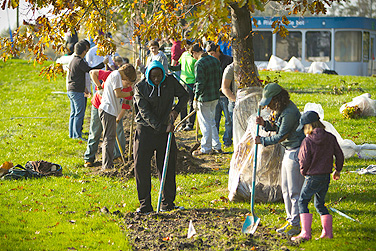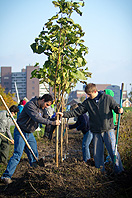News
A new dimension to Solar Strand

More than 100 volunteers planted 90 trees and native shrubs at the Solar Strand site on Flint Road near the Maple Road entrance to the North Campus. Photo: DOUGLAS LEVERE
-
 Print
Print -
 Comments
(2)
Comments
(2)
-

Two volunteers plant a catalpa tree. Photo: DOUGLAS LEVERE
With a thunk and a splat, Andrew Ortego hoisted a long-handled shovel and drove it into the ground, pulling up a clump of dense, water-saturated clay. At his feet was a 15-foot catalpa tree, waiting for its new home in the earth as part of UB’s Solar Strand, one of the largest ground-mounted solar arrays in New York State.
More than 100 UB students, faculty and staff gathered on a crisp and sunny morning on Sunday to plant around 90 trees and native shrubs along either side of Flint Road near the entrance of the array.
The Solar Strand project was designed by renowned landscape architect Walter Hood to be a multi-use site for education, research and sustainable energy. When completed next year, it will produce 750,000 watts of electricity—enough to power 700 student apartments on the North Campus—and help UB with its goal of reaching climate neutrality by 2030. The project is being funded with a $7.5 million grant from the New York Power Authority.
A few yards away from Ortego, a transfer student majoring in geography, another group was being shown how to plant their “Autumn Blaze” maple, one of two species of trees used at the site.
“You have to let the roots spread out, so dig a big enough hole and then replace the soil just up to the root flare, here…” said Albert Gilewicz, assistant director of utility operations for University Facilities, pointing to the crown of the root ball where the roots met the trunk.
Saplings were planted 15 feet apart along mowed strips of waist-high meadow grass on the Solar Strand site. When fully grown, Gilewicz explained, the trees will form a commanding north-south sight line parallel with the solar panels and serve as an integral part of the strand’s unique “DNA” design.
The new vegetation also will serve as a kind of “carbon sink,” meaning it potentially could absorb more carbon than it produces. Discussions are under way with the Department of Geology to develop an undergraduate earth science course for which students would take core samples from the tree trunks to calculate how much carbon the trees have naturally sequestered, part of an effort to infuse the project with learning and research opportunities. Civil engineering students already have mapped the site for an undergraduate surveying course.
Later that morning, groups of four and five volunteers moved across Flint to plant more maples and catalpa, interspersed with serviceberries and witch hazels—both native New York shrubs.
“Wow, that’s a nice straight line!” exclaimed Bob Smith of the Western New York State Nurserymen and Landscapers Association, admiring a row of trees as he sprinted back and forth between diggers. “These bare-root saplings should do well, and this particular type of maple will give a real ‘snap’ of fall color, too,” he said.
The UB crew received supplies and on-site support from Smith’s association, as well as Keep Western New York Beautiful, Re-Tree WNY and Schichtel’s Nursery, which provided the trees and shrubs.
Campus “tree huggers” included several faculty and staff members, as well as members of the Student Association’s Environmental Affairs department, the UB Environmental Network, Greek organizations, UB Green and the UB Outdoor Adventure club.
Ortego, whose group was given two trees to plant, came on his own. “I wanted to do my part,” he said, adding, “I’m a little worried that these two trees won’t cover my carbon footprint from driving over here.”
Also helping out were several engineering students on campus for the 2011 Engineers for a Sustainable World (ESW) National Conference, held last weekend on campus. The conference brought hundreds of environmentally minded engineering students from schools across the country to UB.
Ryan Bonetto, a UB mechanical and aerospace engineering student and a conference organizer, rolled up his jeans, kicked off his shoes and jumped barefoot into the thick mud to prepare a hole for a 4-foot witch hazel. Water immediately seeped into the hole.
“Oozefest came a little early this year,” Bonetto joked, adding, “This was a perfect end to the ESW’s national conference because it allowed students from 18 different universities to participate in UB’s effort to become carbon neutral—something that ESW believes in. I thought it was amazing to see all the people from the community pitching in and helping out.”
“It was heartwarming to see the turnout from our students, faculty and staff, who among others will now be part of the team that is building a more sustainable UB in connection with the Solar Strand,” agreed Chief Sustainability Officer Ryan McPherson, whose entire family joined him at the event. “On a personal note, it was inspiring watching our students talk to my kids about the importance of carbon neutrality and lessening our footprint for future generations.”
Added Gilewicz, who deals with the strand’s logistical challenges: “Despite the boot-eating mud and the difficulty in digging the holes to plant the trees, not one person refused to take on the challenge and get the job done. The UB Solar Strand is about a lot more than solar power.”
By the end of the planting session Ortego had put four trees in the ground. “I think my carbon footprint’s going to be OK,” he said happily.

Reader Comments
Tree Huggers Aren't Partial says:
I'm sure the volunteers did not have the same cynical view of the experience, nor do I believe they (the volunteers) felt taken advantage of.... Infact, I'll bet it motivated people to think even more about the environment and that they can make a difference,and empowered them. Even if it serves an agenda as you say....I don't see any exploitation in bringing people together, building a sense of community and helping out the environment along the way. Every little bit counts, not just the "great forests in California." Also, I'm not cutting you down either (no pun intended) but it is that same pessimistic and cynical attitude that keeps people from pitching in and doing what they can. Try to look at the big picture. an attitude like that will not get you very far in life. xo
Posted by Tree Huggers Aren't Partial, It is the Experience that is important... The warm and Fuzzy is just a bonus, 10/29/11
talk about exploiting environmentalists says:
lets rally up some volunteers so we dont have to pay anyone...well turn it into a community event...there are plenty of trees in buffalo
the trees the treehuggers dont want destroyed are in the rain forest and the great forests out in california because those trees are very old
unpaid labor never looked so warm and fuzzy...ub green...green like money
Posted by talk about exploiting environmentalists, talk about exploiting environmentalists, 10/28/11